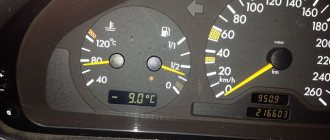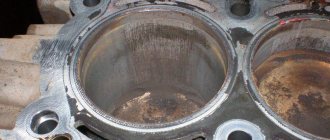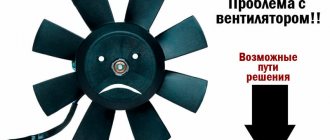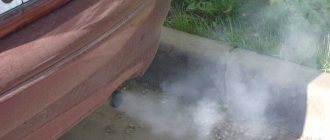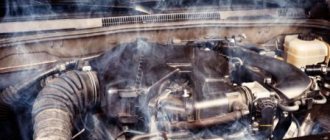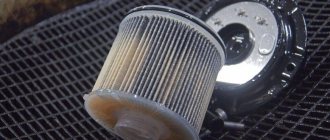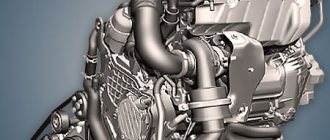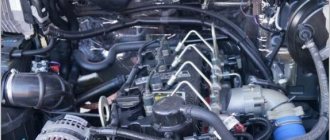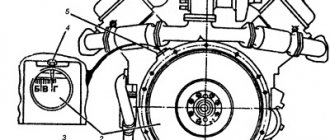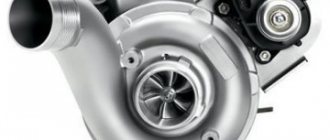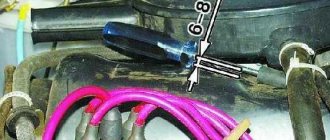Consequences of diesel engine overheating
Let's look at the consequences of engine overheating.
Even the most healthy individual experiences clouding of consciousness from the sun. After a bath or sauna, my heart sometimes hurts. As for a machine, it is much stronger than a person, but everything has its limit. When thermal energy goes beyond the limits, inevitable destruction cannot be avoided. Basically, overheating has its effect on the cylinder head, and gaps appear. To avoid this, the driver must pay attention to the engine temperature. But as practice shows, the driver detects overheating when steam appears from under the hood.
Many car enthusiasts believe that engine overheating most often occurs in the summer. In fact, they are mistaken. Many similar cases in winter indicate the opposite. One of the most popular reasons is a malfunction in the cooling system. From a simple fluid leak to a serious unit failure.
The most vulnerable unit is the water pump. When it is turned off or does not work properly, the liquid begins to circulate poorly throughout the entire system. Also, the main reasons include: poor belt tension, the impeller wears out or breaks.
Probably everyone can say that there is nothing simpler than determining whether the engine is overheated or not using the sensor. But often the driver simply does not pay enough attention to this sensor, being carried away by driving his car. Older cars are not equipped with hazard warning lights in the event of a malfunction. That is why motorists should be aware of the signs of engine overheating and use this knowledge in practice.
The engine can overheat for various reasons, but one of the main ones is the lack of fluid in the system. As a rule, it occurs unnoticed by us, but the consequences can be devastating. The radiator may also be poorly cooled or very dirty.
The radiator is also a vulnerable part of the cooling system. Maybe you've ever had to use the wrong coolant or simply replaced it with water. Over time, scale forms in the honeycombs. Naturally, the liquid begins to circulate with worse intensity.
Among other things, overheating can be caused by a faulty thermostat, and the liquid circulates only in a small circuit. Also, if fuel injection is incorrectly adjusted, overheating is inevitable.
A little theory: how the engine cooling system works
Heat is generated while the engine is running. The cylinders can heat up to several thousand degrees, so in order to remove excess heat and prevent engine overheating, cars are equipped with a cooling system. Essentially, these are special cavities that are filled with coolant (coolant), which washes the walls of the engine, taking away heat from them.
The principle of operation of the cooling system is almost the same for all cars. The main elements of the engine cooling system:
- cooling system radiator
- fan
- thermostat
- water pump
- expansion tank
- interior heating radiator
- interior heating fan
- temperature sensor
- pipelines
The radiator consists of two tanks connected by a large number of tubes. Coolant flows inside them. It flows from one tank to another, passing through tubes. Between the radiator tubes there are many copper or aluminum plates, they increase the heat exchange surface and allow the antifreeze to cool even faster, that is, the liquid transfers heat to the metal, and from it it is removed by air flow from the outside and inside - a fan . Fans are mechanical, driven by the crankshaft, and electric, controlled by the ECU based on sensor data.
The thermostat is a very important element of the engine cooling system. There are two valves inside it. As soon as the coolant temperature becomes higher than the thermostat switching threshold (from 80 to 100 degrees, depending on the car model), both valves change their position, directing the antifreeze in a large circle, that is, to the radiator for effective cooling.
It will be useful: Why the engine oil level has increased: the main reasons
The water pump is located with one part inside the cylinder block, and the other outside. The outer part of the pump is connected by a belt drive to the crankshaft. Thus, the pump transmits movement to its internal part, forcibly moving the coolant inside the cylinder block according to the principle of a pump. This is how the pump forces antifreeze to circulate through the system.
Temperature sensors in the cooling system are also very important. There are two of them. The first, contact, is essentially a thermal switch. Set to a certain temperature (say, 85 degrees), in the event of such readings, it closes its contacts and turns on the cooling fan.
The other sensor is resistive. Inside it is a thermoelement, the resistance of which depends on temperature. Typically, this sensor is connected to the engine ECU and provides information about the antifreeze temperature to the relay that controls the cooling fan.
Other important elements of the cooling system include coolant circulation channels through the cylinder blocks and pipelines, a radiator and heater fan in the cabin, and an expansion tank (where antifreeze is poured). The expansion tank is usually plastic and has two marks - with the minimum and maximum coolant levels, which must be strictly adhered to. The expansion tank cap and radiator cap have valves that regulate pressure and prevent air from the cooling system.
The principle of operation of the cooling system is similar to the two circles of blood circulation in the human body.
While the thermostat response temperature is below the threshold, antifreeze flows in a small circle. When heated in the engine, the liquid leaves the block and cylinder head, enters the tee and is divided into two parts. One part goes to the interior heating radiator, where it cools and goes back to the engine. The other goes to the temperature sensor to the pump, and is pumped back into the engine by it.
When the coolant temperature exceeds the thermostat response temperature, its internal channels switch, and the antifreeze changes its direction, making a large circle. So, one part of the liquid flows in a small circle - through the heating radiator and back into the engine. But the second one moves to the radiator, passes through it and returns to the engine, already cooled.
Then the cycle repeats: antifreeze washes the heated parts, takes heat from them, “travels” to the radiator, where it transfers heat to the tubes and especially the metal fins of the radiator. The large surface area of the radiator fins plus the cool air flow from outside allows the antifreeze to quickly cool down so that it is ready to flow through the water pump and into the engine again. This is what a working cooling system looks like.
The main thing to remember is that a working system will effectively cool the engine and protect it from “boiling.” This is especially true for diesel engines, because the peculiarity of their operation is that less heat is released during fuel combustion than in the case of gasoline engines. Consequently, the risk of “boiling” is lower for diesel engines. So any, even minimal, overheating of a diesel internal combustion engine is already a serious reason for troubleshooting.
First steps when a diesel engine overheats
First, the cause is established. Usually, the pipes, radiator, temperature gauge sensor and thermostat are immediately checked.
It is not so easy to understand why a diesel engine gets hot under heavy load. If the engine is not operated correctly, overheating is also possible. For example, if you constantly move in low gears at high speeds, then in the near future you cannot avoid the engine boiling. It happens that during warming in winter, overheating is caused by engine insulation, which was designed for high temperatures
Once overheating is detected, the causes and consequences of overheating are immediately determined. The engine must be turned off and the vehicle stopped. When the required fluid is added, you should check the fan and hoses for serviceability. If the hoses are cold, the thermostat has stopped working. In this case, the thermostat must be replaced or the valve must simply be turned off to allow circulation through the larger circuit.
If overheating is detected, the engine must be turned off and the hood left in the open position. Next, when the engine has cooled down a little, you need to check the coolant level. If it does not meet the standard, the missing liquid is added. Distilled water can serve as a substitute.
The diesel engine is heating up - how else can you help the engine?
After adding fluid, the operation of the fan is checked, as well as the condition of the hoses coming out of the thermostat. If the thermostat is not working, the hose coming out from below will be cold. This means that fluid circulation occurs only in a small circle. In this case, the thermostat must be replaced or the valve removed from it to ensure fluid circulation in a large circle.
If a leak is detected after topping up, all measures must be taken to eliminate it or to reduce it as much as possible. If adding fluid does not eliminate the signs of overheating, you need to check the operation of the fan drive. It is quite possible that the whole issue is poor contact or faulty fuses.
In exceptional cases, when the cause of overheating cannot be eliminated, and the nearest service station is quite far away, the following method is practiced. The car is driven by the engine until the temperature rises, and subsequent movement is carried out by coasting with the ignition off. At the same time, the temperature drops and you can start moving again. On descents, be careful and drive in gear.
During the operation of any internal combustion engine, malfunctions may occur that lead to overheating of a gasoline or diesel engine. For a diesel engine, overheating is a more serious problem compared to its gasoline counterparts, since a critical increase in temperature can quickly damage the diesel engine due to a number of design features of the unit.
Radiator and thermostat
If the coolant level is normal, but the engine temperature is noticeably higher than permissible, then overheating of the diesel engine may also be associated with a decrease in the efficiency of cooling the liquid in the radiator. Contaminated radiator honeycombs do not allow this element of the cooling system to perform heat exchange normally. In this case, the radiator must be thoroughly washed.
A diesel engine can also overheat due to thermostat malfunctions, namely when the diesel engine thermostat is stuck opening. A constantly closed thermostat does not open as the engine temperature increases, forcing the fluid to move only along a small circuit (small circle). This means that the coolant does not pass in a large circle (through the radiator) for cooling.
The diesel engine is overheating. Causes
Specific causes of overheating include a broken cylinder head gasket. There are two ways: 1) the entry of coolant into the lubrication system becomes inevitable; 2) exhaust gases entering the cooling system. In any case, further operation of the engine without repair is impossible.
Any of the above reasons can be found in a car that has been sitting in a garage for a long time.
Engine is moderately overheated
The interval is more than 20 minutes. The consequences are very unpleasant. One of them:
The engine is very overheated
The reasons are different, but the main one is considered to be inattentive vehicle maintenance. During severe overheating, all parts are susceptible to damage. There are frequent cases of engine explosions. The system of your four-wheeled friend helps prevent this horror - the engine stalls.
Diesel engine overheating - first aid on the road
Thus, when a diesel engine overheats, the consequences can be very severe due to the formation of vapor locks in the head cooling system (the jacket will stop cooling, and the head will overheat and become unusable). This is the most insidious situation, which threatens large losses if it is not eliminated in time; in other cases, the consequences for the engine are not so fatal, and you theoretically have a reserve of time if overheating is not noticed immediately.
After overheating has occurred, it is necessary to find out its cause. In most cases, the culprits are worn hoses, a damaged radiator, as well as a failed thermostat (does not control engine temperature or blocks the flow of coolant in a timely manner), water pump (leaking), or temperature gauge sensor.
Once overheating has been detected, the vehicle must be stopped on the side of the road. The engine must be turned off and the hood opened. After the unit has naturally cooled, the coolant level in the expansion tank is checked. If the amount of liquid is not correct, it must be added. Distilled water can serve as a substitute.
Topping up should only be done on a cold engine to avoid deformation due to temperature differences.
Methods for determining engine overheating
Probably everyone will say that there is nothing easier than determining overheating using a sensor. But often the driver simply does not pay attention to this sensor, being carried away by driving the car. Older models do not provide an alarm at all in case of overheating. That is why motorists should be aware of the signs of engine overheating.
When the fluid level is low, the stove is the first to fail, and all because the radiator is located at the highest point of the cooling system. The stove may also stop working when the antifreeze boils, a plug forms in the system, and the liquid does not enter the stove.
In addition, during overheating, engine detonation occurs; when pressing the gas pedal, the driver hears a loud knocking sound. And all because the walls of the combustion chamber expand too much, and, naturally, the gaps increase.
When a diesel engine overheats, vapor locks form in the cooling head . This can rightfully be called the most terrible situation, which can result in a considerable waste of money.
If after topping up the overheating has not been eliminated, inspect the fan. There may be no contact or faulty fuses.
Consequences of overheating
Minor and short-term overheating of the motor, which is noticed in a timely manner, allows you to minimize the risk of serious consequences. In other cases, overheating of the diesel engine causes great damage to the power unit.
Vapor locks form in the cooling system, causing the cylinder head to overheat. The result of severe overheating of a diesel engine is deformation of the cylinder head and breakdown of the sealing gasket. The cylinder head “drives” due to high temperature, the tightness of the cylinder head to the cylinder block is disrupted.
A significant increase in temperature can also lead to cracks in the cylinder head and cylinder head, and unacceptable expansion of parts in the internal combustion engine structure. In such cases, the motor will simply jam. After cooling, the overheated diesel engine will become unsuitable for further operation. To restore the engine's performance, an expensive repair of the diesel engine or even a complete replacement of the unit will be required.
texako › Blog › Engine overheating. Causes and consequences of overheating.
Engine overheating is a very deep topic and perhaps the most common cause of engine failure, which can lead to much more serious consequences. The causes and consequences of overheating will be described below. There are a great many possible causes of overheating and their number is limited only by a person’s fantasy and imagination.
Well, first, let's look at the most common causes of overheating:
✔ Clogged radiator ✔ Faulty thermostat ✔ Faulty coolant temperature sensor ✔ Fan malfunction, be it an electric fan or a fluid-coupled fan ✔ The water pump drive belt breaks or the pump itself fails ✔ Low coolant level, this can happen if you do not monitor the car or the coolant is leaking a little somewhere. ✔ Overheating occurs much less often in the complete absence of coolant ✔ If the engine starts to run wild, then overheating cannot be avoided either
Slight engine overheating - the engine ran for 5-10 minutes at elevated temperatures. This happens when a fan or thermostat fails, but the driver notices overheating in time and turns off the engine. In this case, the consequences are minimal - the pistons may melt a little, most modern engines may not feel short-term overheating. If the overheating was good, then it will make itself felt with black smoke and the feeling that the engine is constantly running under load, and the engine will also heat up due to the increased friction resistance of the melted pistons and aluminum remaining on the cylinder walls.
Noticeable overheating of the engine - the engine operated at an elevated temperature for more than 20 minutes. The reason could be one of the above or any other. The consequences are the same as with mild overheating, but to a greater extent, plus they may be added to the distortion of the plane of the cylinder head or the formation of a crack in the cylinder head, which can lead to the valve seat flying out. The cylinder head gasket may burn out. The inter-ring partitions on the pistons may be destroyed. On aluminum blocks, the plane on which the cylinder head is installed may be bent. All kinds of oil seals will begin to leak oil.
Severe overheating causes more serious consequences - the engine may knock or seize, much worse if the engine shows a fist of friendship. With severe overheating, the consequences are usually more than serious - almost none of the main working parts of the engine can survive.
It all starts in the combustion chambers of the engine: in the absence of cooling, the pistons begin to melt and burn into the flesh until holes form in them and until they are completely destroyed, molten aluminum sticks to the walls of the cylinders, which makes the piston stroke even more difficult - the engine may stall, or maybe not. At the same time, the engine oil heats up to temperatures at which it loses its properties and becomes like water, lubrication of the rubbing parts stops, the main and connecting rod bearings begin to melt and stick to the crankshaft, after which some of them can turn both on the connecting rods and and in the block - the engine may stall, or maybe not. Under the influence of high temperatures without cooling, the cylinder head begins to deform, valves burn out, one or more valve seats fly out, a sharp loud knock appears in the upper part of the engine - the engine may stall, or maybe not.
Then the finale: the piston turns out to be a tough nut to crack and is the first to fail to withstand the crankshaft - on one of the journals, where the liner was rotated, a crack had formed in advance, just at the point where the crack formed, the crankshaft breaks in half - the engine may stall, or maybe not.
Another scenario: one of the pistons, unable to withstand the overload, jams in the cylinder and breaks in half (as in the photo), the lower part flies into the pan, the upper part remains in the sleeve. The headless connecting rod together with the piston pin begin to dangle in the block and, without hesitation, punch a hole in one of the walls of the block - here it is, the fist of friendship! - the engine will definitely stall.
▪ What it is advisable not to do if overheating occurs.
Source
How to determine if the engine is overheated
Car owners believe that the engine only heats up in the summer. However, they are wrong. This happens most often in winter. The most common cause is a breakdown of the cooling system. This could be a simple fluid leak or serious problems with the unit.
One of the most fragile elements is the pump, i.e. the water pump. If it does not work correctly or turns off, the circulation of fluid through the mechanism deteriorates.
Important! The problem may be a broken or worn impeller and a poorly tensioned belt.
Compressor impeller wear
If your diesel engine is overheating, you need to check the cylinder head. It could have warped (that is, its fit to the block is not tight enough). A breakdown of the gasket is also likely - in this case, the parts also cannot fit correctly to each other. As a result, the entire mechanism deteriorates.
A problem like this requires a complex fix. That is why it is necessary to notice the problem promptly if the motor overheats. The simplest way to control is to look at the readings of the temperature sensor (it is located on the dashboard).
Read more: Engines. Private? V-shaped? "Opposite"?
However, often the problem is revealed only when steam starts pouring out from under the car hood.
Engine overheating is caused by a number of factors. one of them is due to the fact that there is not enough liquid in the cooling system. Almost all holes can leak, so there is a risk of all the liquid leaking out and destroying the mechanism. However, it is likely that the engine could overheat due to poor cooling of the car radiator or its contamination.
You also need to pay attention to the thermostat. If its operation is disrupted, fluid movement occurs exclusively along a small circuit. As a result, there is no cooling. Another possible reason is an incorrectly adjusted injection.
In this case, an increase in the temperature of the exhaust gases occurs. The head is quite difficult to cool: the design is equipped with a specific mesh (jacket), which ensures the distribution of coolant over the entire surface of the mechanism.
Diesel engine cooling system diagram
Let's look at these reasons in more detail.
Lack of coolant is on the list of common causes of diesel heating. The fact is that the coolant gradually evaporates (it contains distilled water). Then experienced drivers add water or dilute concentrated antifreeze or antifreeze with it. The main condition here is compliance with the required proportions. Only after this the mixture is poured into the expansion tank.
Important! Never check the level or pour coolant into the reservoir with a hot engine! Wait for the unit to cool down!
Otherwise, the pressure in the cooling system increases, liquid splashes out of the filler neck, and the person receives severe burns. In addition, if you pour liquid into a hot engine, the temperature difference between the not completely cooled engine and fresh coolant can lead to breakdown of the unit - microcracks may appear.
If the level still drops after adding cooling fluid, you need to check:
- radiator;
- pipes;
- each connection;
- condition of the expansion tank;
- the place where the pump is located (there may be leaks, cracks and other problems here).
Microcrack on the cylinder head
It is very important to inspect the cylinder block with the head and gaskets. The coolant level often drops due to cracks in these elements. If a breakdown is detected in the coolant circulation channels, i.e., the jacket of the cooling system of the unit, part of the coolant enters the diesel cylinders or the lubrication system of the internal combustion engine.
The coolant level may be at normal levels, but the engine will still heat up. This means that the liquid itself is not cooled sufficiently in the radiator. This usually happens due to clogging of the honeycombs. This leads to disruption of heat exchange in the diesel cooling system.
In such a situation, thorough cleaning of the radiator will help. This is enough to eliminate this cause of overheating of a diesel or other engine.
Dirty radiator honeycombs prevent normal coolant cooling
Situations like this happen due to a faulty thermostat. Being in a closed state, it cannot open when the temperature rises. As a result, the liquid moves in a small circle. At the same time, she passes the big circle. It turns out that the radiator cannot cool it.
Other breakdowns
If the motor overheats to a critical level, you need to check the cooling system fan or temperature sensor.
A high degree of contamination of the internal channels of the cooling system can also provoke heating of the diesel engine. As a result, fluid circulation is disrupted.
Periodically clean the cooling system with special products.
If the fuel injection advance angle is incorrectly adjusted, the exhaust gas temperature increases. At the same time, rising temperatures increase possible loads.
As for the pump, you need to look at the condition of its blades. It is their damage that leads to a decrease in the effective movement of coolant throughout the entire mechanism. As a result, the structure may overheat, causing the car owner a lot of trouble.
The most severe consequence of an overheated engine is the appearance of vapor locks in the cooling system. The cooling of the jacket stops, the head overheats and breaks. The situation can lead to serious financial costs if the malfunction is not eliminated in time. However, timely elimination of the problem allows you to get out of the situation and prevent fatal consequences.
As soon as the engine overheats, you need to understand the reasons for what happened. Sometimes it consists of worn-out pipes, a malfunctioning thermostat, or a failed radiator.
As a result, the engine temperature is not controlled, and the coolant flow is not blocked in a timely manner. In some cases, as mentioned earlier, you will have to evaluate the condition of the water pump and temperature sensor.
They could also be causing the problem.
Location of the water pump and thermostat
If you see that the engine has overheated, stop the car immediately. Stop the engine and open the hood. Once the unit has cooled, pay attention to the coolant level. If it is not enough, add it to the expansion tank. You can replace the coolant with ordinary distilled water.
As soon as the driver adds fluid, he needs to inspect the hoses that come out of the thermostat. If the thermostat is not functioning properly or is not working, the lower hose will be cold. This is a sign that the liquid is circulating only in a small circle. The situation requires replacing the thermostat. Another option is to remove the valve, and then the liquid can circulate in a large circle.
If a spot appears, it must be urgently eliminated or at least reduced. If, after adding fluid, overheating cannot be eliminated, the machine’s fan drive may be damaged. Usually the problem is a faulty fuse or lack of contact.
Some car owners believe that to determine the heating of the engine, it is enough to simply monitor the sensor. However, they often don’t look at him while driving. The driver pays more attention to the road rather than to the dashboard indicators.
The reasons for the increase in temperature in the engine are various. However, most often it is a lack of fluid. It is difficult to detect, but the consequences of the problem are very dangerous. Also, as mentioned earlier, the problem could be caused by contamination of the radiator or poor cooling.
We must remember that the radiator is vulnerable. Sometimes motorists replace the coolant with ordinary water or use a fluid that is not entirely suitable for the mechanism. Then the honeycombs become covered with scale. As a result, the intensity of fluid circulation decreases.
Let's pay attention to the thermostat. If the fluid circulates exclusively through a small circuit, this indicates its damage.
Read more: Why does the alternator belt whistle and what to do about it? Basic Troubleshooting Tips
It is imperative to check the condition of the fuel injection. Overheating could occur due to improper regulation.
Prevention
1. Get your vehicle inspected periodically. This is a must. Then it is easier to promptly replace failed parts.
2. Do not overload the vehicle. This is very harmful to the engine, especially during hot periods.
3. Clean the air intakes from dust and dirt!
If you follow these rules, the machine will last a long time and will not require expensive repairs.
Basically, overheating has its effect on the cylinder head, and gaps appear. To avoid this, the driver must pay attention to the engine temperature. But as practice shows, the driver detects overheating when steam appears from under the hood.
Many car enthusiasts believe that engine overheating most often occurs in the summer. In fact, they are mistaken. Many similar cases in winter indicate the opposite. One of the most popular reasons is a malfunction in the cooling system. From a simple fluid leak to a serious unit failure.
The most vulnerable unit is the water pump. When it is turned off or does not work properly, the liquid begins to circulate poorly throughout the entire system. Also, the main reasons include: poor belt tension, the impeller wears out or breaks.
Probably everyone can say that there is nothing simpler than determining whether the engine is overheated or not using the sensor.
But often the driver simply does not pay enough attention to this sensor, being carried away by driving his car. Older cars are not equipped with hazard warning lights in the event of a malfunction.
That is why motorists should be aware of the signs of engine overheating and use this knowledge in practice.
Signs, causes and consequences of car engine overheating
One of the most dangerous and common problems that entails serious consequences in the form of a major overhaul of the internal combustion engine or its replacement is engine overheating. This problem mainly occurs in the summer, but some faults can cause this problem in cooler periods. It is easier to avoid overheating of the car's heart than to later eliminate the serious consequences of even a single excess of operating temperature. To do this, you need to know the symptoms and ways to quickly eliminate such a problem.
Reasons why the engine may overheat
The cooling system, which can be filled with antifreeze, antifreeze or plain water, protects the internal combustion engine from overheating.
The main devices that monitor operating temperature and reduce it are:
A malfunction in any of the above components can lead to overheating. In addition to malfunctions of the above devices, overheating can be caused by both external factors and other internal faults.
External overheating
If symptoms of overheating appear, it is necessary to carry out an external inspection of the radiator, motor and cooling system.
The main causes of external overheating:
Internal overheating
There are many reasons for internal overheating, and not all of them can be detected visually, and some will have to be looked for by a qualified car mechanic.
Causes of internal combustion engine overheating:
What to do if the engine has already started to overheat
If overheating has begun or is suspected, it is necessary to take immediate action to avoid serious problems with the engine in the future.
If the needle has just entered the red zone (overheating zone), then you can turn off the engine, but it is advisable to cool it a little by turning it on to the maximum temperature and blowing on the stove.
In any case, it is necessary to inspect the radiator and engine compartment. If there is liquid in the expansion tank, then you can cool the engine a little by turning on the heater fan to the maximum temperature and blowing mode.
If there is a complete absence of coolant in the tank, turning on the heater at maximum mode will not help cool the internal combustion engine, and may worsen the situation. In this case, it is necessary to turn off the engine and transport the car to the repair site using a tow truck.
If minor leaks are detected in the cooling system after the engine has cooled, it is possible to add water or coolants. Under no circumstances should you add any liquid to the expansion tank of a hot engine, since the difference in temperatures can lead to cracks in different components of the internal combustion engine or other consequences.
It is strictly forbidden to water the engine, since in this case its repair is inevitable due to the appearance of cracks in the cylinder block body.
An overheated engine is turned off only in certain cases: when steam appears from under the hood, indicating a significant leak in the cooling system, or a complete absence of coolant in the tank.
Even a slight overheating of the motor, at best, will lead to unpleasant consequences in the future, and significant overheating can almost completely destroy its insides, which will lead to the need to install another motor.
Such situations can be prevented; to do this, it is necessary to constantly monitor the coolant level, do not pour water into the cooling system, change the cooling pump and working fluids in a timely manner, regularly inspect the pipes for the appearance of cracks in them, and monitor the cleanliness of the radiator and engine housing.
Source
What to do if the engine overheats
If the engine temperature indicator is approaching or is already in the red field, you must stop the vehicle in a safe place and turn off the engine. Then check the cooling system. It may turn out that overheating of the car engine is caused by a lack of refrigerant, which in this case needs to be replenished as soon as possible.
Do not forget that it is forbidden to top up when the engine is hot - you need to wait until the temperature of the internal combustion engine and the coolant itself drops. Otherwise, the driver will be subject to severe burns when opening the expansion tank.
You should also remember that you cannot add cold antifreeze to hot antifreeze - this may adversely affect its properties.
Engine overheating: signs, causes and consequences
He will unexpectedly appear when you are not expecting him at all... We share tips: how not to boil the engine and what to do if you have already seen smoke from under the hood.
During the operation of any internal combustion engine (ICE), a large amount of heat is generated. To prevent overheating, the machines are equipped with a cooling system: it keeps the engine operating temperature within optimal limits (usually from 85 to 105°C). Like any other technically complex part, the cooling system sometimes malfunctions, as a result the temperature rises to critical values, and this can lead to very serious consequences.
What are the dangers of engine overheating?
Let's not dramatize: sometimes it passes without major consequences. It all depends on the degree of overheating, which can be divided into three parts.
Slight overheating. An attentive driver constantly monitors the coolant temperature. A temperature sensor needle “hung” in the red zone is a good reason to check the cooling system, and at the same time the engine. Daily “heating” of the engine is harmful.
Average. Steam from under the hood is a more serious problem. If this happens, you need to urgently stop, wait until the antifreeze cools down, top it up (if any) and try to start the internal combustion engine. After this, it is better to check the engine at a service station, because it could be damaged during the “boil”.
Strong. This usually happens if the engine “boils” due to a faulty cooling system, which the driver did not know about. The most common consequences of engine overheating sound scary and are expensive: melted pistons, cracked cylinder heads, twisted liners, broken crankshaft.
Do not delay your visit to the service center if the power unit suddenly starts working as before and no longer heats up. Next time it may “boil” with consequences.
Modern turbocharged engines are most sensitive to overheating. Tuned engines are also “at risk”. Even after replacing the software (and chip tuning is rightfully one of the most affordable and popular options for increasing engine power), the temperature regime often changes and becomes unstable.
Diesel engine overheating
During the operation of any internal combustion engine, malfunctions may occur that lead to overheating of a gasoline or diesel engine. For a diesel engine, overheating is a more serious problem compared to its gasoline counterparts, since a critical increase in temperature can quickly damage the diesel engine due to a number of design features of the unit.
Checking the thermostat
Designed to be sensitive to changes in temperature, regardless of changes in pressure in the coolant system, the service thermostat will limit the circulation of antifreeze to a small circuit through the cooling jacket of the block and cylinder head. As the temperature difference between the environment and the engine increases, the thermostat smoothly opens the coolant supply from the main radiator to the engine. This is exactly what happens in the opposite case. Thanks to this, the temperature limits of engine operation are maintained and limited, and the vehicle interior is heated.
To determine whether the thermostat is working correctly, it is not necessary to remove it. All this is done manually when the engine starts. After warming it up for about five minutes, you can go check the operation of the thermostat. Immediately after starting, the coolant will circulate only through the engine cooling channels during heating. Its heating occurs directly in the car engine and in the radiator. The pipe that goes in the opposite direction from the radiator to the engine should be cold. If something is wrong, then there is a reason to have the thermostat checked by a specialist, and that is why the engine does not heat up well.
READ Toyota Corolla won't start reasons
The most common causes of engine overheating
Let's start with the basic truths: a car and the engine in it are subjects of increased responsibility. They need to be serviced regularly, without waiting until one day the car gets stuck somewhere in a traffic jam.
Low antifreeze level. It’s trite, but many people open the hood only in winter to fill in antifreeze, although you need to monitor the oil and antifreeze levels at any time of the year. Air pockets can form in the cooling system if the coolant is constantly at a minimum. Because of this, the motor is at constant risk.
Causes of car engine overheating – what to check first?
As a rule, after overheating, the cylinder head warps (a gap appears, i.e. it no longer fits properly to the block), its gasket breaks through (responsible for the tightness of the parts, so violating its integrity harms the entire mechanism), after which a complex repair. Therefore, when a diesel engine gets hot, it is necessary to detect the malfunction in time. To do this, you need to regularly monitor the temperature indicator located on the instrument panel. However, very often engine overheating is detected when steam is already appearing from under the hood.
It will be useful: Reasons for oil getting into the engine cooling system
There are many reasons why an engine overheats. The main one is the lack of fluid in the cooling system. Leaks can occur from any opening, and such leaks can lead to a complete lack of fluid and the most destructive consequences. There are other circumstances that cause diesel engine overheating, related to ineffective cooling of the car radiator or severe contamination.
In addition, overheating can occur due to malfunctions of the thermostat, when the liquid begins to move only along a small circuit, and in it it is not cooled, since this path in most models does not pass through the radiator. In general, the reasons can be a variety of factors, for example, incorrect injection adjustment when the temperature of the exhaust gases rises sharply. Moreover, cooling of the head occurs in difficult conditions; there is a special jacket (mesh) to which coolant is supplied over the entire surface area.
How to prevent overheating?
First of all, monitor the technical condition of the vehicle and go for maintenance on time. In unauthorized technical centers, maintenance is often understood as changing engine oil and filters, without paying attention to full diagnostics. At any FAVORIT MOTORS Group dealership, each vehicle must be checked in accordance with the manufacturer’s technical data sheets. Specialists cannot do this every day. Therefore, you need to monitor the coolant level in the tank and the information on the fluid temperature gauge. Also, any deviations in engine operation (knocking, difficulty starting, etc.) should be a cause for concern.
What to do if the internal combustion engine starts to overheat?
There is a big gap between the two questions - how to deal with engine overheating and why the engine overheats. The engine can fall into the “red zone” for many reasons, and you probably won’t be able to guess the correct one right away, unless you are a professional mechanic and there is no puddle under the car. Problems must be solved as they arise, so first we don’t let the engine get stuck, and then we look for the reasons.
At the first sign of boiling, we immediately stop on the road. After this, check the coolant level. Open the hood carefully - you may get hot steam.
It is highly undesirable to try to cool an overheated engine yourself. There have been cases when car owners, with the best of intentions, poured cold water directly onto the internal combustion engine - as a result, the cylinder head (and sometimes the block itself) cracked, forcing major repairs. Be patient and wait - the engine will cool down on its own.
When the steam stops flowing and the seething in the tank stops (if there was any), you need to assess the situation. If you do not have experience repairing a car, you are unlikely to understand the reason for the engine overheating. Carefully inspect the details of the engine compartment. Perhaps one of the cooling system pipes has come off or a crack has formed in the radiator: in this case, you can see a puddle under the problem area. But more often than not, no external signs can be recognized. In this case, you need to add antifreeze (or, in extreme cases, water) into the expansion tank and try to continue the trip.
How to get to the repair site without risk to the engine?
Overheating usually occurs in hot weather or in traffic jams. It makes sense to wait until the evening to get to the repair site on your own without any problems: it will become cooler and the traffic will decrease. There are several life hacks that will increase your chances of getting to your destination without overheating the engine.
Turn the heater on to maximum. Your task is to remove as much heat as possible from the cooling system. The stove will take away the excess heat from the engine, but at the same time you risk boiling yourself.
Keep the revs to a minimum. We mean the minimum possible for normal movement. In this case, the load on the engine will be less, which means less heat will be generated during operation. On vehicles with a manual transmission, you can upshift earlier than usual. Cars with an automatic transmission usually have a manual mode: move the selector knob to it and control the ranges manually.
Any suspicions? Let's check!
While it is easy to check the condition of the radiator or the fluid level in the expansion tank, the average driver will not be able to find out anything about the thermostat, water pump, or the quality of antifreeze. Antifreeze usually lasts 5 years; the pump, depending on the model, is changed every 60,000 - 100,000 km. More exact dates can be found at the nearest FAVORIT MOTORS Group dealership: if you suspect that the engine is overheating, sign up for diagnostics right now. Remember that real overheating is always a big expense, which is actually easy to avoid.
Source
